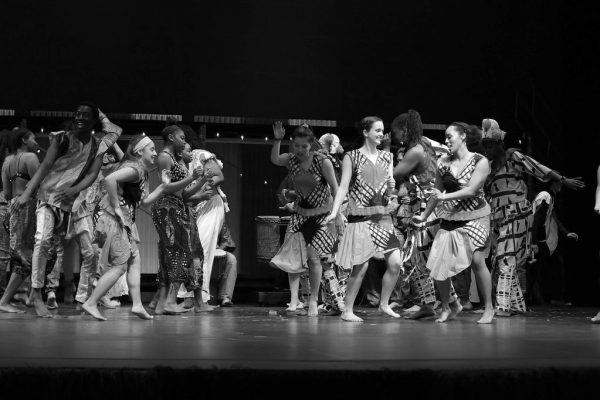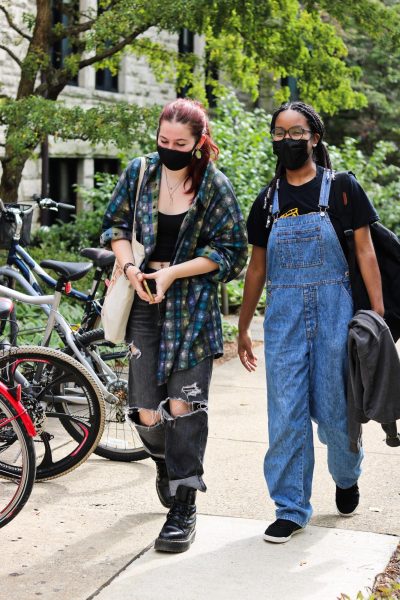Carmen Ambar and Bobby Fuller: Contrasting Two Presidencies
Editor’s note: This column is part of a series that will focus on Oberlin’s history as a town and an institution. The series will be published regularly throughout the fall semester.
“The time is ripe for a new look at the fundamental propositions and the fundamental building blocks that underlie a liberal arts college education.”
So said Robert Fuller, Oberlin’s 10th president, in his 1970 opening address to the Oberlin community held in Finney Chapel. But it could have been said just as easily by President Carmen Twillie Ambar, Oberlin’s 15th president, who came to Oberlin in 2017 with a similar vision — to respond to broader shifts in higher education by reforming the Oberlin experience.
According to Geoffrey Blodgett, a longtime History professor who had been on the faculty for a decade by the time Fuller’s tenure began, Oberlin’s trustees expected Fuller — just 33 years old at the time — to shake things up from the beginning.
“Fuller arrived with a mandate from those who chose him to launch a radical restructuring of Oberlin’s educational and governance arrangements — to bring the college in line with the needs of students as it emerged from the 1960s,” Blodgett wrote in an essay included in his collection titled Oberlin History.
As Blodgett references, the transition from the ’60s into the ’70s was a particularly formative and traumatic time on campus. Against the backdrop of civil rights activism, protests against the Vietnam War, and emerging advocacy for racial, sexual, and gender rights on college campuses and in cities across the country, Oberlin students frequently found themselves grappling with their role in an unjust world.
Then, in the span of two weeks near the end of spring 1970, the very first Earth Day and the horrific shootings at Kent State University took place, as well as a significant anti-war protest and occupation of Cox Administration Building. Oberlin shut down for the rest of the semester, and many felt that reforms were needed in order for the institution to move forward.
Enter Robert Fuller. Fuller’s time in Cox certainly resulted in a number of attempted reforms, some successful, others not. His was also the shortest presidency in Oberlin history, lasting only about three-and-a-half years.
One of Fuller’s first major initiatives as president was forming the controversial Education Commission. The purpose of EdCom, as it came to be known, was to “review and rethink education at Oberlin,” according to the Nov. 13, 1973 issue of The Oberlin Review.
This task is not dissimilar from the charge given to the steering committee of the Academic and Administrative Program Review by Ambar and the Board of Trustees in September 2018. Like EdCom, the AAPR — which concluded its work this past spring — spent about a year evaluating and strategizing, before ultimately submitting its recommendations to the president and board.
Both EdCom and the AAPR, at different points in their processes, also faced charges of elitism from the campus community, who felt as though the goals and priorities of each review were out of touch with campus concerns. In the case of EdCom, the pushback largely came from faculty; for the AAPR, it was students and union leaders that expressed concern about compensation for hourly workers.
According to Review coverage of Fuller’s resignation, EdCom’s recommendations, like the AAPR’s, were far-reaching.
“Its final report, released a year later, called for drastic changes in the structure of the College, including a full-year modular calendar, tuition deceleration, redesigning of courses, and granting of credit for traditionally non-academic activities,” the Review published on Nov. 13, 1973 (“Fuller Analysis: Why Did He Resign?”).
However, where the AAPR succeeded in generating broad-based campus support for nearly all of its proposals — earning nearly 80 percent support from Oberlin’s faculty and a unanimous endorsement by the Board of Trustees — EdCom faced significant resistance, especially from members of the faculty.
Some parts of Fuller’s vision were successful, though, such as the elimination of academic distribution requirements, which would later be reinstated. Still, those victories were tense, and the ultimate nail in the coffin of Fuller’s presidency was his belief that faculty governance at Oberlin was fundamentally flawed and needed to be reformed.
For anyone who knows how fiercely the Oberlin faculty cling to their independence under the auspices of the Finney Compact, the swift and strong rebuke to Fuller’s attempts to expand the powers of the presidency should come as no surprise. The short version is that the trustees passed a bylaw in June 1973 granting Fuller oversight of faculty lines; the faculty protested and very narrowly voted down a proposal to unionize. Fuller announced his resignation five months later.
According to Blodgett, this brief episode was so significant and institutionally unnerving that Oberlin was forced to spend “the next decade quietly knitting itself together.” However, this statement appears largely informed by Blodgett’s vantage point as a professor. While the faculty largely felt threatened by what they viewed as administrative overreach, not all faculty members opposed Fuller. Further, many students saw merit in his proposals.
Reflecting upon Fuller’s presidency, the Review’s Editorial Board wrote on Oct. 22, 1974 that Fuller “served as an important catalyst for educational reform” (“You Say Hello… I Say Goodbye”). In particular, students seemed to support Fuller’s work to provide greater access for Black students and women, his advocacy for ExCo, and his general visibility around campus.
This is not to say that students ignored the consequences of Fuller’s bull-in-a-china-shop approach.
“The openness, dynamism, and many of the educational ideals that Fuller brought to Oberlin should be preserved, but to them must be added an appreciation of existing interests and problems and a spirit of tact and compromise,” the Review’s Editorial Board wrote earlier in 1974, in a Jan. 1 issue that also marked Fuller’s departure from campus (“Interim Presidency: A Time to Heal Past Wounds”).
That spirit of tact and compromise which proved to be Fuller’s greatest foil has been, to this point, one of Ambar’s greatest strengths in her own attempts to shape Oberlin. Throughout the AAPR process, Ambar kept herself at a distance, emphasizing her respect for autonomous faculty governance. It was not until the final public forum before the recommendations were submitted to her office that she even appeared publicly alongside the steering committee that she had formed more than a year prior.
While Ambar is doubtlessly operating in a different political climate than Fuller was, examining the varied success of their different approaches reveals that parts of Oberlin’s campus culture — namely the fierce defense of faculty autonomy against presidential overreach — have not changed much through the decades. So, too, some of Ambar’s rhetorical justification for the AAPR mirrors Fuller’s from more than 40 years ago.
“We’re at one of those watershed spots this year,” Fuller said in the Feb. 1, 1974 issue of the Review (“Fuller’s Last Stance”). “We have a lease on life. We have a chance. I hope we’ll make it, but the odds are against any such place making it. The place can continue but it’s got to become something significant and special, or it’s failed.”
Oberlin students of today can recognize this justification — that Oberlin must stand out from its peers in a world that is not friendly toward small liberal arts colleges. Fuller had a plan for these reforms, but was ultimately not the person for the job — only time will tell if Ambar is, but her presidency is already off to a more tactful start.
And it’s worth remembering that, though the road to change is long and fraught, there is value in a community coming together to shape its collective future — a process that students, faculty, and staff have engaged in wholeheartedly over the last year and more. This collective advocacy, if the story of Fuller’s presidency is any indication, will — for better or for worse — reverberate throughout the years.
“In the future we may look back nostalgically to those few years when Oberlin students turned their political energies to the task of educational reform and were joined by a faculty ready to change, uninhibited by financial pressure and job insecurity,” wrote Associate Professor of English John Hobbs in a Nov. 13, 1973 letter to the Review editors (“The Fuller Years: A Period of Innovation and Diversification”). “The Fuller years were good years for Oberlin. We may wonder when such times will come again.”




